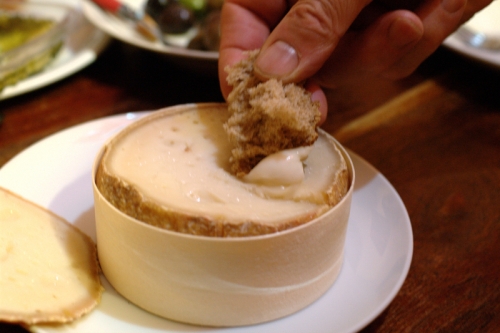This flower produces patches of bright yellow foam along the roadside in June. As usual with plants whose English name includes the word ‘ Lady’ , this is a reference to the mother of Jesus. According to Grigson, Mary’s bedstraw when she gave birth was supposed to contain both this plant and bracken. The latter did not ‘acknowledge the child’ and lost its flowers, while the Galium ‘welcomed the child’ and blossomed on the spot, its flowers having changed from an ordinary white to a brilliant yellow. Look, I don’t know how a plant is supposed either to fail to acknowledge or to welcome anyone, I’m just reporting this stuff, OK? In any case, the legend seems to me to mark the incredibly bright yellowness of these flowers, and may also derive from the use of the plant in olden days to make mattress stuffing, because of the its honey and hay scented foliage.
The yellow ‘foam’ composed of tiny 4-petalled flowers
So why am I writing about this now, four months after I took the photo? Because I wanted a cheesy theme, and the French name for the plant, Caille-lait jaune, comes from its supposed ability to curdle (cailler) milk. Another name is Gaillet jaune – a mix of the preceding name and the Latin Galium, which in turn comes from the Greek gala, milk. However, just as with any story concerning virgin birth, it’s a good idea to check the facts. Plenty of websites, dictionaries and encyclopedias repeat the milk-curdling assertion, but there’s little evidence of the plant being used in this way, and in France the Appelation d’Origine Controlée regulations for cheese insist on the use of animal rennet. Those who have tested Galium verum on milk have found that it’s not verum or true at all: it has no coagulating properties – the myth is debunked on this French goats’ cheese site. It is said however, that it was used in the making of Cheshire cheese to impart a yellow colour and particular flavour – but this practice may have ceased by the 19th century.
So over to a more reliable story which started with my post about thistles (here). Regular commenter Ceridwen pointed out that thistles were used in the Extremadura region of Spain to curdle milk for cheese. Looking this up as she advised (see for example this web page on thistles) put me on the trail of the Torta del Casar, a sheep milk cheese from Casar de Càceres in Extremadura, a trail which ended in success in Valencia’s Mercat Central a few weeks ago. In fact it seems widely available in Spain – we saw the same cheese in a market in Barcelona too – though perhaps not abroad, since only about 10% of production is exported.
Thistle cheese and thistle stems
The cheese has ‘protected origin’ status since 1999, which means that it must be made in the Casar area, with milk from Merino and Entrefina sheep, whose milk yield is so low it takes the milk of 20 sheep to make a kilo of cheese, and there are now only about ten family dairy farms producing it. It has to be matured for at least 60 days, and is soft, protected by a round wooden box. Despite all that, it wasn’t expensive. The recommended way to eat it is to cut off the top like a lid, and scoop out the cheese with bread. The one we bought was maybe a bit firm for this, but it had a strong, mature salty taste which was quite unique, and went well with a bottle of red wine from the southern Spanish Bobal grape variety. We also found a jar of ‘cardo’ – cooked thistle stems – in the same market. Just some of the reasons why we intend to go back to Valencia.
Instant sheep cheese fondue
When I look something up in a dictionary, I always look around on the page for anything else interesting, and just above ‘GAILLET’ in Le Petit Robert I saw ‘GAILLARD’, meaning sprightly, as in ‘vieillard encore très gaillard’ which is a motto I’ll try to live up to now I’m in my 60s. And for jazz fans, there’s an obvious link : here’s the Slim Gaillard Trio with ‘Dunkin’ Bagels’ – in the coffee, not the cheese, but who cares with a performance that’s as much fun as this.
Coming up soon: Botany epitome. What can that be? Wait and see.





I’m delighted to read this. Lady’s Bedstraw is a plant I learnt to recognize in early childhood when my father would identify the flowers we came across on our walks and I would often found the names curious and memorable. I love the scent of it which is, as you rightly say, richly honeyed.
Also, we now have a very similar cheese – Golden Cenarth – produced locally, although not from sheep’s milk, nor thistles.. It also comes in a wooden box for heating and dipping into. It’s very delicious so do look out for it when you make your next visit to Wales.
Yes, this is one of those plants with lots of names and I had four dictionaries open on my desk. I try to rein it in a little because I think etymology is more interesting for the blog writer than the reader. I’ll certainly look out for the Golden Cenarth – there are a lot of very good cheeses in West Wales even if, curiously, I haven’t heard of anyone making it from milk from all those sheep.
As I was reading this, I thought how like it is to a “Ceridwensian” Blip–meaning it includes a memorable image (or several), has a wealth of information, makes surprising connections, and includes history and sensuality. How fitting that the first comment came from Ceridwen!
There is no greater compliment – thank you!